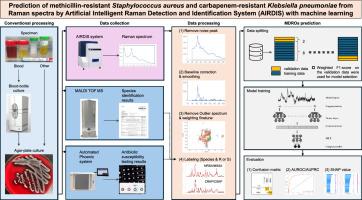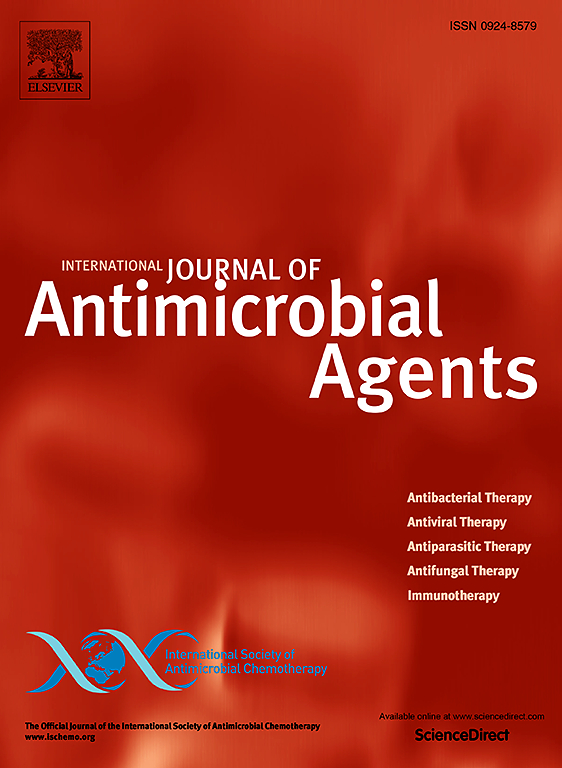基于机器学习的人工智能拉曼检测识别系统(AIRDIS)对耐甲氧西林金黄色葡萄球菌和耐碳青霉烯肺炎克雷伯菌拉曼光谱的预测。
IF 4.6
2区 医学
Q1 INFECTIOUS DISEASES
International Journal of Antimicrobial Agents
Pub Date : 2025-07-30
DOI:10.1016/j.ijantimicag.2025.107587
引用次数: 0
摘要
耐甲氧西林金黄色葡萄球菌(MRSA)和耐碳青霉烯肺炎克雷伯菌(CRKP)是两种最重要的抗生素耐药细菌。早期使用正确的治疗策略不仅可以降低患者死亡率,还可以防止耐药性的发展。虽然有一些快速但昂贵的技术可用,但临床微生物实验室的常规工作流程有时需要数天才能提供细菌鉴定和耐药性概况。在本研究中,我们开发了一种结合拉曼光谱和机器学习的细菌鉴定和耐药性预测系统来预测MRSA和CRKP。共收集到金黄色葡萄球菌988株(包括513株MRSA)和肺炎克雷伯菌1053株(包括517株CRKP)。其中,266株金黄色葡萄球菌和285株肺炎克雷伯菌用于培养,其余用于验证。该系统具有较高的预测性能,预测MRSA的准确度为88%,预测CRKP的准确度为87%,预测CRKP的准确度为0.96。因此,我们证实了机器学习在临床微生物学实验室解释拉曼光谱以预测耐药细菌的能力。这是第一个经过大量临床分离物验证的新型系统,可以纳入现有的工作流程。本文章由计算机程序翻译,如有差异,请以英文原文为准。

Prediction of methicillin-resistant Staphylococcus aureus and carbapenem-resistant Klebsiella pneumoniae from Raman spectra by Artificial Intelligent Raman Detection and Identification System (AIRDIS) with machine learning
Objectives
Methicillin-resistant Staphylococcus aureus (MRSA) and carbapenem-resistant Klebsiella pneumoniae (CRKP) are two of the most important antibiotic-resistant bacteria. Early use of the correct treatment strategy can not only reduce patient mortality but also prevent the development of resistance. Although some rapid but costly techniques are available, routine workflows in clinical microbiology laboratories can sometimes take several days to deliver bacterial identification and resistance profiles. In this study, we developed a bacterial identification and resistance prediction system that combines Raman spectroscopy and machine learning to predict the MRSA and CRKP.
Methods
A total of 988 S. aureus isolates (including 513 MRSA) and 1053 K. pneumoniae isolates (including 517 CRKP) were collected. Of these, 266 S. aureus isolates and 285 K. pneumoniae isolates were used for training, while the remainder were used for validation.
Results
The system demonstrated high predictive performance, with accuracy and area under receiver operating characteristic (AUROC) values of 88% and 0.92 for MRSA prediction and 87% and 0.96 for CRKP prediction, respectively.
Conclusions
As a result, we confirmed the ability of machine learning to interpret Raman spectra for predicting resistant bacteria in clinical microbiology laboratories. This is the first and novel system validated with a large number of clinical isolates and may be incorporated into existing workflows.
求助全文
通过发布文献求助,成功后即可免费获取论文全文。
去求助
来源期刊
CiteScore
21.60
自引率
0.90%
发文量
176
审稿时长
36 days
期刊介绍:
The International Journal of Antimicrobial Agents is a peer-reviewed publication offering comprehensive and current reference information on the physical, pharmacological, in vitro, and clinical properties of individual antimicrobial agents, covering antiviral, antiparasitic, antibacterial, and antifungal agents. The journal not only communicates new trends and developments through authoritative review articles but also addresses the critical issue of antimicrobial resistance, both in hospital and community settings. Published content includes solicited reviews by leading experts and high-quality original research papers in the specified fields.

 求助内容:
求助内容: 应助结果提醒方式:
应助结果提醒方式:


